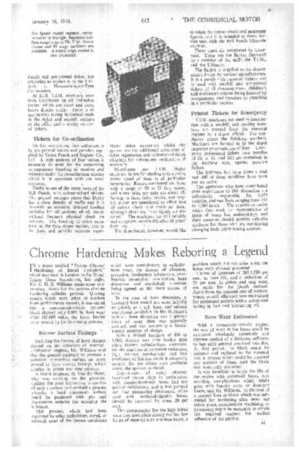Chrome Hardening Makes Reboring a Legend
Page 35

If you've noticed an error in this article please click here to report it so we can fix it.
IN a paper entitled "Porous Chrome 1 Hardening of Diesel Cylinders,'.' which was read in London to the Diesel Engine Users Association, last night, Mr, C. D. B. Williams made some outstanding claims for the porous chrome hardening cylinder process. Quoting results which were taken at random from performance records, it was stated that a commercial-vehicle cylinder block showed only 0.002 in. bore wear after 100,000 Miles, the bores having been treated by the hardening process.
Mirror Surface Failings
Outlining the history of hard chrome deposit on the cylinders -of internalcombustion engines, Mr. Williams said that the general tendency to produce a polished, mirror-like surface on bores proved to have certain failings, which resulted in piston and ring seizures.
A Dutch engineer, H. Van der Horst, who was working on the problem, realized the poor lubricating properties of Rich a surface and evolved a process' whereby a hard chromium surface could be produced with pits and depressions suitable for retaining the lubricant.
This process, which had been exploited by other technicians, cured, or relieved, most of the known conditions which were contributory to cylinderbore wear, the factors of abrasion, corrosion, inadequate lubrication, overheating, incomplete combustion, bore distortion and crankshaft vibration being agreed as the main causes of wear.
In the case of bore distortion, a hardened bore would not wear initially as quickly as a soft bore, and seizure was almost inevitable. In Mr. Williams's opinion, bore distortion was a greater cause of wear than was generally realized, and was essentially a fundamental problem of design.
With a Brinell hardness of 800 to 1,000, chrome was little harder than other known cylinder-bore materials, but the qualities of corrosion resistance, high thermal conductivity and low coefficient of friction made it eminently suitable for use where such problems arose, the speaker declared.
Experiments of . using chromehardened piston rings in conjunction with chrome-hardened bores had not proved satisfactory, and it was pointed out that piston-ring clearances, when used with hardened-chrome bores, should be increased by some 20 per cent.
This compensated for the high initial wear that took place during the first few hours of running with cast-iron bores, a problem which did not arise when the bo'res were chrome processed.
Claims of increases of 200-1,000 per cent, in bore life, and a reduction of 75 per cent. in piston and ring wear, are made for the Dutch method. Apart from the reduced cost of replacements, overall efficiency was maintained for prolonged periods with a substantial saving in fuel and lubricating oil.
Bore Wear Estimated
With a commercial-vehicle engine, the rate of wear in the bores could be estimated absolutely accurately and chrome applied of a thickness sufficient to last until general overhaul was due. At that period, the block could be stripped and replated to the nominal size, a process which could be repeated any number of times until the block was eventually discarded.
It was beneficial to begin the life of the engine with processed bores, thus avoiding complications which might arise with heavily worn or damaged liners, said Mr. Williams. In the case of a normal liner or block which was submitted for hardening after wear had taken place, considerable machining or processing might be necessary to obtain the required surface for perfect adhesion of the plating,












































































